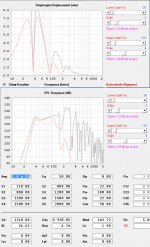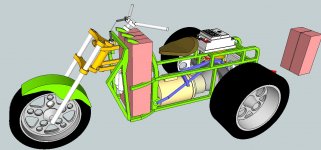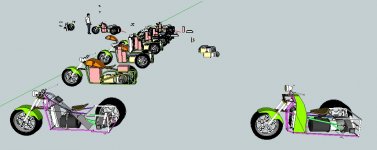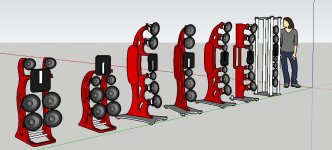hehe, I'm actually sitting here on hornresp right now. (Lateshift, its 730 here!!!)
However I do need to go pick up my girlfriend from school shortly.
the original SS18, was designed for use with a 38 hz hipass filter
I'm confused why you entered an RE of 5.3, considerin the 18ps76 has an RE of 5.
i'll post pics in a second.
However I do need to go pick up my girlfriend from school shortly.
the original SS18, was designed for use with a 38 hz hipass filter
I'm confused why you entered an RE of 5.3, considerin the 18ps76 has an RE of 5.
i'll post pics in a second.
The additional gain relatively small "barn doors" can impart to any type of cabinet to the LF cutoff was a surprise to me.
Art
It's a surprise to me too. The Danley measurement I posted awhile back doesn't seem to have any of this going on.
I kind of skimmed the first post of both threads, I'll need to take a lot more time to read the threads, analyze the actual size of the cabs and the size of the complete stack and the added boundary extenders before I can even begin to have an opinion on these measurements.
Once I realized how the "Measurements" box worked, it has really made things a lot easier. I was trying to stretch things perfectly and was getting very frustrated.
I have been punching holes in things per your instructions all day today, I am glad I finally understand that process. Thanks again. Do you use SketchUp professionally at all, or just as a hobby?
The right click "Entity Info" is also an invaluable tool. I make most of my circles 60 segments to make them smoother looking.
I have been using it to design my own electric trike for the last couple of years. So I have done countless revisions using sketchUp and even modelled a few speakers. I have spent thousands of hours using it for personal use.
Attachments
hehe, I'm actually sitting here on hornresp right now. (Lateshift, its 730 here!!!) However I do need to go pick up my girlfriend from school shortly.
Well Sine143 (aka young lad), at a certain point in life, late is anything after supper time. All my regular advisors are asleep already. It's only you and Silent Screamer (who's on the other side of the world, where it's probably morning) keeping this old man company tonight.
I watched part of a documentary on Katy Perry with my grand daughter this evening. Now that I am up to date on pop culture, I better work on my horn folding techniques before I fall asleep too.
here's my best bet... notice my input parameters for the driver are different than yours. I just went off whatever they had on the BC site. 50 volts, 36hz 12 db oct BW hipass filter.
Nice work, thanks for helping me understand this correctly. It is interesting to see the effects of the upper cutoff too, really smoothing off that mess above 175Hz.
My first steps with Hornresp were just taking proven cabinet designs and changing drivers in them to see what differences that made. I actually modeled that B&C driver a few months ago, probably getting the information off Parts-Express.com. Humm, makes me wonder about the accuracy on the specifications they are providing.
Here are some links to posts exploring the effect of boundary enhancement (AKA "Barn Doors" or "Horn Extenders)
http://www.diyaudio.com/forums/subwoofers/184986-horn-extender-wave-guide-th.html
http://www.diyaudio.com/forums/subwoofers/204472-multiple-cabinet-combined-response.html
Art, nice links. I had seen another persons forum topic on barn doors on his subwoofers, but I hand't noticed your when scanning through the forum archives. I will browse through those in more detail at work tomorrow. Thanks.
The right click "Entity Info" is also an invaluable tool. I make most of my circles 60 segments to make them smoother looking.
I have been using it to design my own electric trike for the last couple of years. So I have done countless revisions using sketchUp and even modelled a few speakers. I have spent thousands of hours using it for personal use.
Hey Paul, thanks for the tip.
Nice looking trike. You definitely know what you are doing with SketchUp. Those speakers look very cool too, I blew that picture up a bit to get a better look - those are some very modern designs.
Those are just a few of the crazy ideas I have come up with. Just let me know if you need to know anything specific... One last tip I tend to copy and paste a lot, you wind up with lots of variations of the same thing, but it is a lot easier than trying to remake the modifications again. Just select like I showed you then ctrl c then ctrl v (trying to get it to go where you want is quite an art) remember to deselect the copied version once you make it...
Attachments
Last edited:
DHAA, theres a reason why danleys graphs only go up to 150 or so 🙂
Honestly my lopass (110) is probably a little high (for a subwoofer at least)
you probably know more about katy perry than I do now. My girl and I listen to/make weird underground (bass) music.
Honestly my lopass (110) is probably a little high (for a subwoofer at least)
you probably know more about katy perry than I do now. My girl and I listen to/make weird underground (bass) music.
here's my best bet...
Looks good, I get a ~same-same response except a bit less net Vb, so a little less mid bass peak SPL.
GM
Attachments
It's a surprise to me too. The Danley measurement I posted awhile back doesn't seem to have any of this going on.
Why? The little extra LF extension is due only to the increased mouth end correction just as HR predicts.
GM
This probably isn't news to you guys, but I just realized I could install a second copy of Hornresp so I can easily compare similar designs side-by-side. That is very useful for me and my attempt to have a deeper understanding of the effects of these design changes.
GM, would you care to make any comments on what prompted those particular design changes?
If I understand some of just a guys comments, you seem to have some sort of proprietary horn modeling system. If so, there is no need to share you secret formulas, but how about a few hints on how that came about?
Looks good, I get a ~same-same response except a bit less net Vb, so a little less mid bass peak SPL.GM
GM, would you care to make any comments on what prompted those particular design changes?
If I understand some of just a guys comments, you seem to have some sort of proprietary horn modeling system. If so, there is no need to share you secret formulas, but how about a few hints on how that came about?
Last edited:
Question of the Day - Area Displacement of a Speaker within a Horn Path
This question pertains to either:
- S3 in a three segment tapped horn
or
- S4 in a four segment tapped horn
Since the question applies to either of these two types of folds, so that there is no confusion as to what I am talking about, that particular area measurement for both of those horn types will hence forth be referred to as Sx.
The question is, since Sx is always at the same point as the rear of the driver, wouldn't it make sense to subtract the area displacement of the driver from the area of the horn at that point to have the correct area measurement for that point of the horn?
In my reading, I don't' think I have ever heard anyone mention doing that. But with some of these massive subwoofer drivers, the area displacement of the driver could easily reduce the effective area of the horn by 20-30% it seems.
Anyone have any thought on this?
This question pertains to either:
- S3 in a three segment tapped horn
or
- S4 in a four segment tapped horn
Since the question applies to either of these two types of folds, so that there is no confusion as to what I am talking about, that particular area measurement for both of those horn types will hence forth be referred to as Sx.
The question is, since Sx is always at the same point as the rear of the driver, wouldn't it make sense to subtract the area displacement of the driver from the area of the horn at that point to have the correct area measurement for that point of the horn?
In my reading, I don't' think I have ever heard anyone mention doing that. But with some of these massive subwoofer drivers, the area displacement of the driver could easily reduce the effective area of the horn by 20-30% it seems.
Anyone have any thought on this?
Last edited:
Since this "Hornresp Brainiac's" post has started, I have learned so much I am astounded. I am very thankful for all the help I have been given. You generosity and goodwill truly amaze me.
I feel I have made giant steps in understanding the proper design of a tapped horn and the proper use of Hornresp. And surprisingly, I think I have made great progress in SketchUp (which I am really starting to enjoy).
But I seemed to have hit a roadblock with folding my Hornresp designs into actual cabinets. I have so many thought swimming around in my mind I feel overwhelmed. So yesterday I went bad to post #1 and starting re-reading everything once again.
I have realized that I was receiving so much information from you guys, so fast, that I wasn't fully processing all your comments. I am sure I have appeared pretty daft, as I now realize I would ask questions that you have already answered. So I would like to apologize for that - from this point on I will try to fully think through all your comments before moving on to the next one.
I would also like to thank all of you that have found links to refer me too in order to gain better knowledge of a certain subject. Some of those links I had seen before, but it was early in my quest and I didn't understand the details. I think I am starting to see the light at the end of the tunnel.
For me, this forum format, where one idea is posted after another, not necessarily in sequence, is a bit confusing. So, I have printed out some of the helpful drawings and comment you guys have provided about the specifics of horn folding. I am going to start from scratch and and get this TSF15 folded, if it is the last thing I do. And if things start getting ugly I have my crow bar ready. This thing in going in, and that is my final answer.
Thank you Brainiac's.
I feel I have made giant steps in understanding the proper design of a tapped horn and the proper use of Hornresp. And surprisingly, I think I have made great progress in SketchUp (which I am really starting to enjoy).
But I seemed to have hit a roadblock with folding my Hornresp designs into actual cabinets. I have so many thought swimming around in my mind I feel overwhelmed. So yesterday I went bad to post #1 and starting re-reading everything once again.
I have realized that I was receiving so much information from you guys, so fast, that I wasn't fully processing all your comments. I am sure I have appeared pretty daft, as I now realize I would ask questions that you have already answered. So I would like to apologize for that - from this point on I will try to fully think through all your comments before moving on to the next one.
I would also like to thank all of you that have found links to refer me too in order to gain better knowledge of a certain subject. Some of those links I had seen before, but it was early in my quest and I didn't understand the details. I think I am starting to see the light at the end of the tunnel.
For me, this forum format, where one idea is posted after another, not necessarily in sequence, is a bit confusing. So, I have printed out some of the helpful drawings and comment you guys have provided about the specifics of horn folding. I am going to start from scratch and and get this TSF15 folded, if it is the last thing I do. And if things start getting ugly I have my crow bar ready. This thing in going in, and that is my final answer.
Thank you Brainiac's.
Last edited:
Why? The little extra LF extension is due only to the increased mouth end correction just as HR predicts.
GM
Weltersys isn't showing any LF extension at all, he's showing a 3 db increase in spl across the sub's entire bandwidth. This is surprising to me. He even mentioned he was surprised. His measurements are not even similar to what Hornresp is predicting or what DSL's measurements show.
Relatively small "barn doors" (for instance, doubling the frontal area of the Keystone TH and other FLH) can increase the on axis level by an average of 3 dB down to Fc.
The measured gain from two small cabinets is generally only 6 dB over one cabinet.
The extra 3 dB I mentioned was doubling the frontal area of a larger area than 17 x 48.
The additional gain relatively small "barn doors" can impart to any type of cabinet to the LF cutoff was a surprise to me.
Last edited:
The question is, since Sx is always at the same point as the rear of the driver, wouldn't it make sense to subtract the area displacement of the driver from the area of the horn at that point to have the correct area measurement for that point of the horn?
Ideally, yes. Practically, no.
Ideally you would subtract the volume of the driver out of the area that the driver occupied volume in the flare. Practically there's no way to do that. Hornresp doesn't have enough segments. If you reduce Sx (let's say it's a 3 segment horn and it's S3), then you are actually affecting the entire area from S2 to S4 if you decrease S3. This doesn't accurately reflect the situation at all.
Ideally, yes. Practically, no.
Thanks just a guy for that succinct answer. That is one less problem rattling around in my mind.
Hi DHAA,
Post #213: "...S3...S4...Sx...subtract the area displacement...don't' think I have ever heard anyone mention doing that..."
That dog has been beaten to death in:
http://www.diyaudio.com/forums/subwoofers/170771-single-sheet-th-challenge.html ,and
http://www.diyaudio.com/forums/subwoofers/190635-th-18-flat-35hz-xoc1s-design.html
I don't have time right now to find the detailed references, and just a guy has pointed out what happens to the simulation if you try to do this in Hornresp.
To see what happens you have to set the horn flares to Con, export to AkAbak, and add at least two more segments to the horn path: one from the original cross-section down to the reduced cross-section at the driver, and one from there back to the original horn path. I have tried this, and it didn't make any great difference. But it is certainly something to keep in mind.
Now, on the other side of the driver, coupling the driver with a reduced entry opening through a throat chamber to the horn does seem to make a difference in how much power the driver will survive, and can be simulated in Hornresp. For information on that see:
http://www.diyaudio.com/forums/subwoofers/131852-live-sound-specific-tapped-horn-thread.html
That goes hand in hand w/ cone correction, and for that see the Xoc1 thread again.
Regards,
Post #213: "...S3...S4...Sx...subtract the area displacement...don't' think I have ever heard anyone mention doing that..."
That dog has been beaten to death in:
http://www.diyaudio.com/forums/subwoofers/170771-single-sheet-th-challenge.html ,and
http://www.diyaudio.com/forums/subwoofers/190635-th-18-flat-35hz-xoc1s-design.html
I don't have time right now to find the detailed references, and just a guy has pointed out what happens to the simulation if you try to do this in Hornresp.
To see what happens you have to set the horn flares to Con, export to AkAbak, and add at least two more segments to the horn path: one from the original cross-section down to the reduced cross-section at the driver, and one from there back to the original horn path. I have tried this, and it didn't make any great difference. But it is certainly something to keep in mind.
Now, on the other side of the driver, coupling the driver with a reduced entry opening through a throat chamber to the horn does seem to make a difference in how much power the driver will survive, and can be simulated in Hornresp. For information on that see:
http://www.diyaudio.com/forums/subwoofers/131852-live-sound-specific-tapped-horn-thread.html
That goes hand in hand w/ cone correction, and for that see the Xoc1 thread again.
Regards,
GM, would you care to make any comments on what prompted those particular design changes?
If I understand some of just a guys comments, you seem to have some sort of proprietary horn modeling system.
I didn’t rethink sine143’s design if that’s what you mean. I just ‘ran the numbers’ when Chano first posted, planning to post it as part of a response to show it needn’t be all that large once he started his own thread, but the extraordinary weather has kept me from finishing it, so just posted it as a sort of a +1 when I saw sine143’s, i.e. either one seems a viable design or at least gives Chano a couple of good examples to modify to maybe find something even more suitable for his app.
Well, I’ve a proprietary Excel design routine based on my understanding of how to convert a compression horn alignment into higher order BP/TP/TH ones in both imperial and metric units using math long time available in AES papers, patents and more recently posted on the net, so the ‘secret’ isn't the math, just knowing how to apply it.
GM
Weltersys isn't showing any LF extension at all....
Ah, OK, haven’t the time to review his yet, so no clue ATM.
GM
- Status
- Not open for further replies.
- Home
- Loudspeakers
- Subwoofers
- Hornresp Brainiacs - Help an Old Man




